...And Also The Trees
Having breakfasted in fine fashion at the Log Cabin near Symonds Yat Rock (see Rocking Around the Forest), I retraced my steps through the trees and eventually emerged onto the minor road to Coleford. It didn't take me long before I found a signpost. It wasn't a great deal of use, to be honest – I already knew where I was, and travellers wouldn't exactly be spoilt for choice. To the north lies the village of Symonds Yat; to the south lies Coleford. There's not much in between, unless you count Berry Hill/Christchurch. But it confirmed that the strange twisting path through the forest hadn't totally confused my sense of direction. I was heading south, exactly as planned.
The signpost also advised me that Coleford was two miles away. Once again I found myself in the unenviable position that Achilles had been in when racing the Tortoise. I was pretty sure that I'd walked a lot further than two miles to get to Symonds Yat in the first place. I looked at my phone and it was about half past ten. That meant that I had roughly forty-five minutes before the bus left for Cinderford. This in itself was an exciting piece of information.
[A digression: That last sentence probably won't mean anything to you unless you're familiar with the South Wales Valleys. Let me spell it out for you: I was in the middle of rural England, on a Sunday morning, and I was on my way to catch a bus! Please bear in mind that the earliest we see a bus in the Valleys on a Sunday is early in the afternoon – always assuming you're one of the lucky people who live in an area which has Sunday buses at all. (For the tear-jerking story of my first – and last – bus journey on a Sunday morning in Wales, please see Nice Work If You Can Get There.) Now you can see why I was so excited by the prospect.]
I wasn't especially worried about missing the 1123 departure. After all, there'd be another one along in two hours. But I was heading to Cinderford for a reason. Maria B. had tipped me off about a good place to visit – Littledean Jail. It's a former prison which has been converted into a 'Black Museum', and she'd described it as 'a tad macabre.'
I'd actually had a choice of tourist spots to visit on the Sunday: the Dean Forest Railway, which runs between Parkend and Lydney, was running steam specials that day; Clearwell Caves, which have been used as a location for Doctor Who a couple of times, are an easy walk from Coleford; Coleford itself has a Railway Museum. It would have been impossible (not to mention expensive) to fit them all in, so eventually I'd settled on Littledean Jail, just outside Cinderford.
I hadn't been able to find out very much about it beforehand. Maria had sent me a link on Facebook, but I wasn't able to access the website in the Library. The filters had blocked it because it apparently contained 'adult material.' That sold me on the idea straight away. I was keen to catch the 1123 bus to Cinderford, a short distance from Littledean. If the website is 'adults only', then the museum itself must be pretty cool!
I made my way along the minor road, which was surprisingly busy for a Sunday morning. I suppose people must have heading home from church, and of course there must have been a fair number of tourists heading for Symonds Yat as well. One car drew up as I was strolling casually towards Coleford; the driver wound down the window and asked me if I could point him in the direction of Butterfly World. I apologised and told him that he was asking completely the wrong person. It's Sod's Law that if you're lost, the first person you meet will also be a stranger to the area.
A little further on I passed a parish noticeboard, which informed me that I was in English Bicknor. However, I'd seen English Bicknor Church indicated on the circular plaque at Symonds Yat Rock, with an arrow pointing roughly east – surely I hadn't managed to lose my way during that short walk.
[caption id="attachment_8458" align="aligncenter" width="460"]
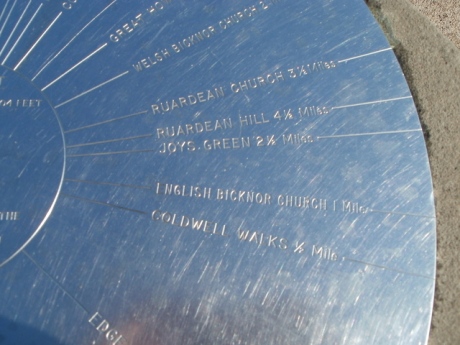 Needless to say, there's a Welsh Bicknor as well.
Needless to say, there's a Welsh Bicknor as well.They're on opposite sides of the River Wye.[/caption]
A quick look at the map reassured me that while I might have been in the parish of English Bicknor, the church was indeed some distance to the east. I was, in fact, making my way through the village of Hillersland, and there was a pub marked on the map. It was too early for opening time, of course, but when I got to it, there was no sign of life. It looks as though it's been yet another victim of the War on Pubs.
A little further on, I found an interesting little post at the side of the road:
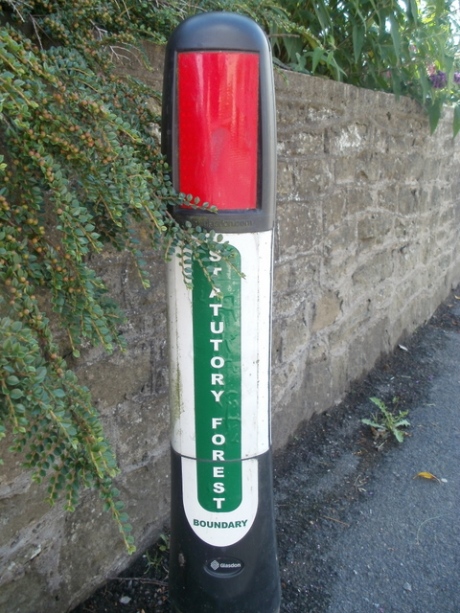
This exact spot is marked on the Pathfinder map, where the Forestry Commission land ends and the local authority land begins. I was almost back in Christchurch/Berry Hill, where my journey had begun a few hours earlier. An elderly gentleman on a bike greeted me cheerily as he sped past, and a couple of large farm dogs made their presence known as I passed their gate. A couple of minutes later I heard the bells of Christ Church ringing out across the fields. I've never been a churchgoer, but I still find there's something strangely haunting about the sound of church bells when you're in the countryside. Whenever I'm walking through rural villages like those, I get the feeling that anyone who doesn't attend church every week is probably treated with great suspicion by the locals (when they're not re-enacting weird pagan rituals themselves, of course.)
The only other time I've been in an English village on a Sunday morning was the day that Martin E., Benji and I came back from Cropredy, many years ago. I found myself feeling rather odd, being on my own and miles from home. Even had I wanted to, I wouldn't have been able to get home very easily – I'd have had to travel through the Forest of Dean to Lydney, caught a train from there to Cardiff, and then made my way up the Valley on one of the two-hourly trains that we're treated to on a Sunday. As things stood, I was left completely to my own devices.
I checked the time again, and reckoned that I'd be lucky to make it to Coleford in time for the bus. According to the latest signpost, not far from Christchurch, I was still ¾m from Coleford – and I'd been walking for a lot more than half an hour. I know from experience that I can average 4 mph on foot, so clearly something weird and Zeno-like had happened again. I quickened my pace and found myself on a fairly gentle slope which curved round to my right, lined with council houses on one side and a steep grassy bank on the other. From there, I could clearly see Coleford Church on its hill above the town.
With my target more or less in sight, I was dismayed to see a double-decker Stagecoach bus approaching from the direction of the town and pass me on the hill. I checked my phone for a time check. It was only quarter past – I suddenly had a horrible feeling that I was back in Public Transport Land, that mystical realm where drivers devise their own schedules, and only local people know that timetables aren't worth the paper they're printed on. Rather disappointed, I carried on walking into town and arrived at the square.
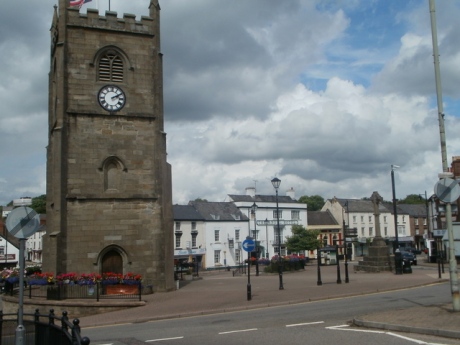
Nothing was open. And I mean, nothing, unless you count the Co-op in its little pedestrian square, and the Tesco and Nisa stores which sit cheek-by-jowl in the main street. There was a nice-looking café near the war memorial, but that didn't open until midday.
The previous evening I'd spotted an independent bookshop, tucked away a few doors from the bank. That wasn't open either. I hadn't really expected it to be open, in fairness. I'd only walked that far because I wanted to visit the ATM. I'm so used to cashpoints which offer users a choice of English or Welsh that an English-only terminal came as something of a surprise.
[A digression: Naj and I were talking about bilingualism one day, and she remarked that when her cousins came down from London, the ATM in Aberdare offered to transact their business in English only. I teased her that she'd have a shock if, one day, she inserted her card and was presented with a menu in Bengali. It might happen soon, if smart technology continues to roll out across the world.
Another time, Leafy had acquired a mobile phone, and while his back was turned, we changed it to use Turkish as its default language. We told him that he'd have to go for a kebab at the end of the night, and ask the guys in the shop for Tech Support. (Changing it back to English was hard work, believe me!)]
Anyway, I took out some cash and walked back to the square, only to see a double-decker bus pull into the stop outside the Angel Hotel. It was a 31 – the service to Gloucester via Cinderford. In other words, it was the bus I'd thought I'd missed about ten minutes earlier. I boarded and bought a Forest Rover ticket, which cost £5 and covers pretty much the entire Forest area, down as far as Lydney. I hadn't come across any mention of it on the Stagecoach West website, and guessed that it was a fairly new development. Next time I go there, I'll know exactly what ticket to buy.
The bus retraced the route I'd taken into Coleford, but from my vantage point on the upper deck I was able to get a much better view of my surroundings. One sign in particular amused me:
[caption id="attachment_8467" align="aligncenter" width="460"]
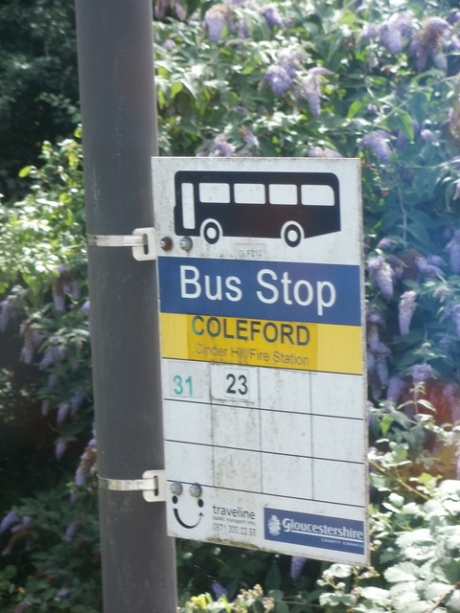 The Fire Station is on Cinder Hill - how appropriate is that?[/caption]
The Fire Station is on Cinder Hill - how appropriate is that?[/caption]We arrived at the junction I'd passed about twenty minutes earlier and turned right. It had crossed my mind to take a leisurely stroll through the Forest to Cinderford, which (according to the road signs) was only seven miles away. Then I'd remembered my previous experiences with Gloucestershire Miles vs Statute Miles and thought better of it. As the bus trundled along the route, picking up passengers here and there, I felt instinctively that I'd made the right decision. It wasn't exactly the scenic route. In fact, it was a pretty mundane journey through small village centres – seven-day-a-week general store, pub, community centre, church – and 1960s housing estates, only enlivened by the occasional light industrial park, builders' merchant, agricultural feed supplier, garage, farm shop, FE College outpost, and (in Coleford's case), a large GlaxoSmithKline factory on the outskirts of the town.
[A digression: In David Nobbs' classic comic novel The Death of Reginald Perrin (1975), our eponymous hero goes on a bus tour through England, trying to lose his old identity and find a new life for himself. Instead, he finds himself in a succession of bogus olde-worlde tourist traps. ('Five antique shops, four potteries, three boutiques', he muses after one disappointing break of journey.) Forty years on, the antique shops have been undercut by David Dickinson's TV shows, and the potteries and boutiques are all trading online.]
Throughout the journey I'd spotted brown 'tourist attraction' road signs, pointing to Clearwell Caves, the Forest Railway, the Forest Heritage Centre, and other tempting places which I've logged for next time. Then, in Brierley, about halfway along the route, we passed a rather attractive pub in the middle of nowhere:

I mean, it really is in the middle of nowhere. Even on the OS map, the blue 'pint glass' symbol gives the impression that it's been plonked there by mistake. Weirdly, The Swan Inn is a Georgian theme pub. That doesn't mean that it's been decorated in Regency style – instead, it specialises in the cuisine of the Caucasus. I bet their Eurovision Song Contest theme parties are something else.
We began the ascent into Cinderford, and I noticed the name of a school on the approach road. I had a weird feeling that they used to be Dillons account customers many years ago – why else would the name 'Steam Mills School' ring a bell? By now you'll have noticed a bit of theme emerging in the place names of the Forest of Dean. Like the valleys of South Wales, it was a coal-mining area – but it was exploited many centuries earlier. (According to The Oxford Dictionary of Names, both Coleford and Cinderford were first recorded in the 13th Century.) This could explain why, on disembarking at Cinderford a few minutes later, I felt a strange sense of familiarity with the townscape.
If the Forest of Dean ever declares independence from Gloucestershire, Cinderford has a decent claim to be its county town. Even so, it's compact, neat, clean, and remarkably quiet on a summer Sunday afternoon. I was expecting somewhere a bit more tourist-focused. Maybe it's a good thing that it's managed to steer clear of the 'five antique shops, four potteries, three boutiques' scenario. Its steep main road, narrow side streets, majestic buildings, and (above all) the atmosphere of recently-departed prosperity, reminded me that I wasn't that far from home. A stone's throw from the bus station I found these fantastic monuments to the town's past:

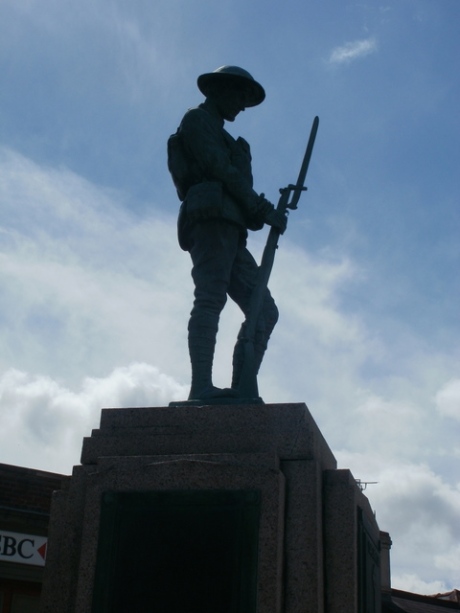
Ranged at the base of the war memorial are four bronze plaques bearing the names of literally a couple of hundred people who died in the World Wars. When you consider that coal mining was a reserved occupation in 1939-45, it's extraordinary to think how many local people served and died in the armed forces.
Not far off the main street I found another sign of the Forest's industrial past:
[caption id="attachment_8471" align="aligncenter" width="460"]
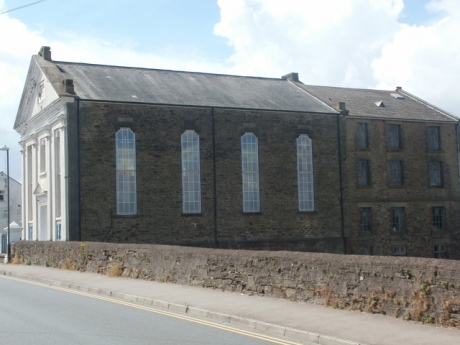 This chapel must have been huge even before the extension was built.[/caption]
This chapel must have been huge even before the extension was built.[/caption]I was amazed to find that it was still active – some elderly ladies were on their way out as I walked past the main door. A little further along, I found another chapel, which has been converted into flats.

If you lived in one of these flats, this is more or less the view you'd have from your back window:
[caption id="attachment_8473" align="aligncenter" width="460"]
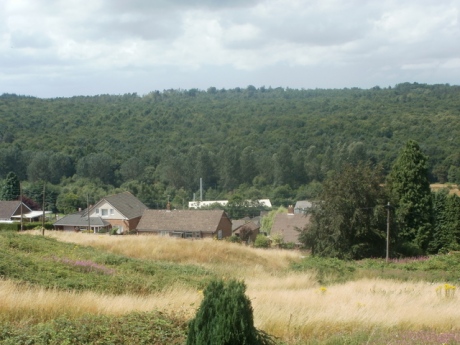 You can't see the wood for the trees.[/caption]
You can't see the wood for the trees.[/caption]I didn't know it at the time, but I was heading in completely the wrong direction for Littledean. It didn't matter, though, as I stumbled upon a yet-to-open shop which must be worth a visit on another occasion:
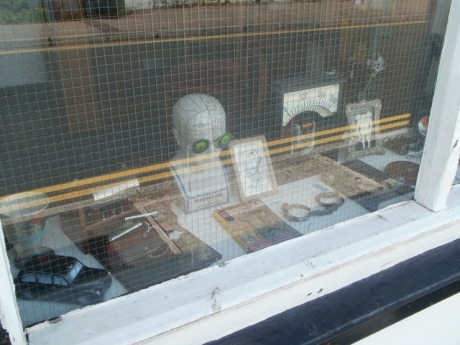
It's called 'Curioddities', and according to a sign in the window, the owners claim to be 'Dealers of the odd and unusual.' Just inside the door, there was a large poster for something called 'The Rock'n'Roll Circus' (I think!), an extravaganza featuring, among others, Genesis P. Orridge. There was a mobile phone number on the window sign, but no website. I'll give it a month or and check to see whether they've opened for business. Those vintage darbies would look just the job amongst my bondage gear.
I arrived at a road junction and discovered that I'd been heading in entirely the wrong direction. Now, if I'd stayed on the 31, in about another five minutes or so I'd have been in Littledean itself. On the other hand, I'd never have found Curioddities. Brian Eno's Oblique Strategies cards offer a famous piece of advice to the creatively-blocked: Honour thy error as a hidden intention. I think my unintended detour through the back streets of Cinderford must have been a classic illustration of that maxim. I followed the road up a steep hill and eventually came to a rather treacherous road junction, just on the edge of the town centre. I managed to cross to the other side and my eye was immediately drawn to this house at the top of the hill.
[caption id="attachment_8475" align="aligncenter" width="460"]
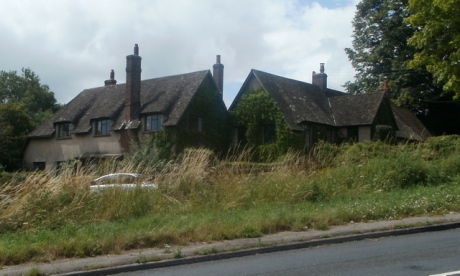 I don't know whether this is one house or two. I'd be happy with half of it.[/caption]
I don't know whether this is one house or two. I'd be happy with half of it.[/caption]I'm not sure about its neighbour a couple of hundred yards downhill, mind you:
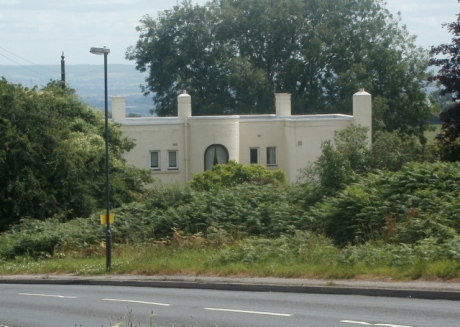
At the top of the hill I'd seen a brown signpost for Littledean Jail. Apparently it was a half a mile away. Anyway, I kept walking and descended into Littledean itself. There isn't much to see. It's a quintessential English Village: it's won the Best Kept Village Contest a couple of times, and has been Highly Commended for another few years. It boasts some beautiful old houses built of sandstone, a pub and a hotel on the main road, a couple of interesting monuments, and a war memorial in the grounds of the United Reform Church. There's a huge disused pub on a street corner. There's also a sign telling visitors that Littledean Jail is ¼m away. Finally, just on the edge of the village, you come across one of those churches that just fills your eyes and your viewfinder with its ancient solidity:
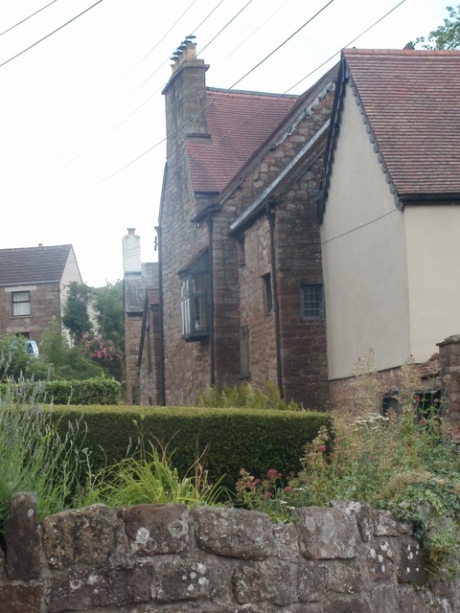
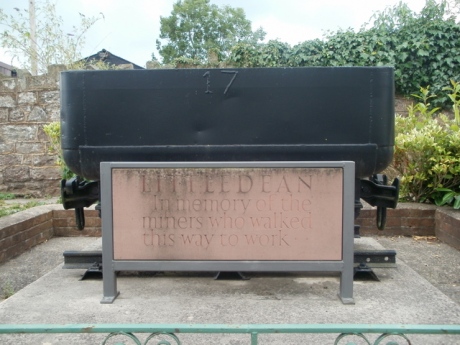
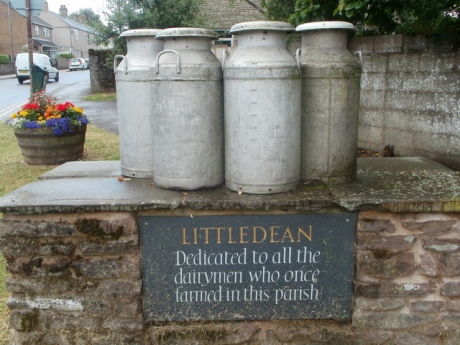
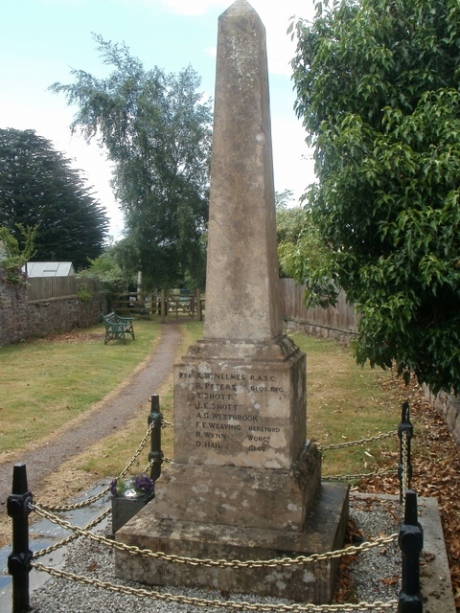
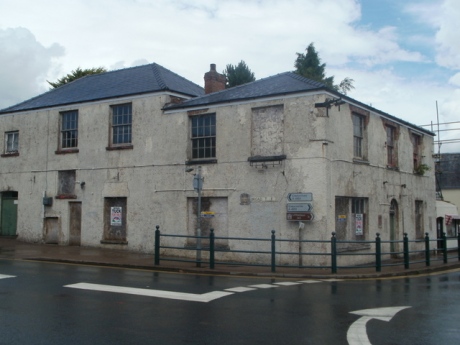
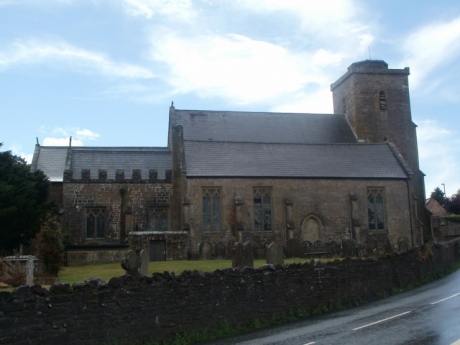
Hang on a moment, I hear you think, where did this river in the street come from? There's blue sky in the photo.
Yes, gentle reader, there was indeed blue sky just two minutes before I passed St Ethelbert's Church. There's also blue sky in this picture, taken about five minutes later. In between, the heavens opened again. The river which you see flowing past the boundary wall wasn't there when I started to descend the hill towards Littledean Jail. By the time I reached the entrance to the jail, I was soaked to the skin! As quickly as it had begun, the 'sharp shower' (a meteorological euphemism for 'suddenly pissing down') had finished and the sun was out. However, unlike Achilles, I'd finally reached my target:
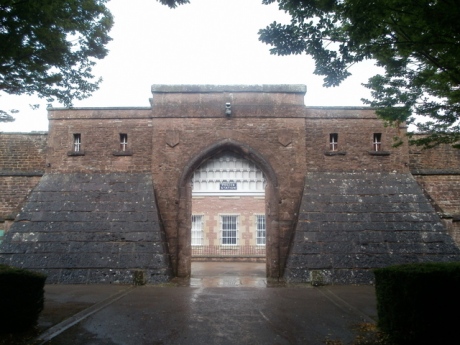
And that's actually as far as I got. Just inside the gates there's a poster detailing the admission prices. I didn't have eight quid on me. Eight bloody quid! It was no wonder the information leaflet I picked up afterwards warned potential visitors that they 'might find some of the content offensive.' Eight quid per person is pretty bloody offensive, in my humble opinion. I turned around, walked back to the village, and had a glass of Coke while I waited for the bus back to Coleford.
There was a very odd crowd in the pub, and (not for the first time) I reflected upon the DVD extra commentary to The Singing Detective. There's a scene where Philip Marlow recalls an episode from his childhood, in a working men's club in the Forest. His father (played by the wonderfully lugubrious Jim Carter) is singing a duet with his friend Raymond Binney (Patrick Malahide), while Mrs Marlow (Alison Steadman) plays the piano.
http://www.youtube.com/watch?v=WUStvMsnNXM
The 'extras' in this scene were all drawn from the villages of the Forest, and at one point Jon Amiel (the director) remarks, 'You don't get faces like that from Central Casting.' I think I might have encountered the last generation of these true Forest faces, undiluted by outside genetic influences. In fact, I'm pretty sure they were in the pub in Littledean. As an outsider and (worse still) a tourist, I must have stood out like a spare dick at an orgy. I wasn't sorry to get back on the 31 and retrace my steps to Coleford. I couldn't help thinking that somewhere on the outskirts of the village there was an enormous wicker man with my name on it.
Comments
Post a Comment